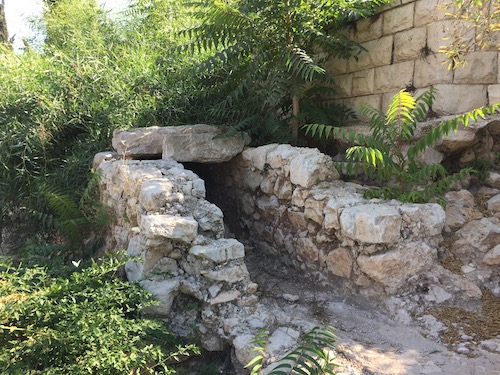Pontius Pilate was the governor of the Roman province of Judea from AD 26 to 36. He’s famous for presiding over the trial of Jesus of Nazareth and sending Jesus to the cross.
We don’t have a huge amount of information on Pilate, but there’s a famous story that shows what kind of a man he was. You can read the story yourself in the works of the Jewish historian Josephus, in his book Antiquities of the Jews 18:60-62, and also in his earlier work Wars of the Jews 2:175-177.
The story begins with Pilate looking rather good. He offered to build an aqueduct to bring water into Jerusalem.
Why an Aqueduct?
You may be wondering what’s so great about an aqueduct? Didn’t Jerusalem have water already?
Yes, it did, but not enough. It had the ancient Gihon spring, which dated to long before the time of King David, who ruled roughly 1000 BC. That worked fine when Jerusalem was a village with a few hundred souls, but by the time of Jesus, it was a largish city of at least 30,000 people. (At that time, in this part of the world, a city of 30,000 was considered quite large.)
And Jerusalem was growing. Houses were springing up outside the city walls on the north side, in the area called New City.
A city needs water, and especially a city with a large temple. As it happened, the Jewish Temple in Jerusalem was the largest temple in the known world. And temples thrive on sacrifices, which produce blood, which needs to be washed away.
At the time, there were already several aqueducts bringing water in to Jerusalem. Here’s a picture of one that I took a few years ago just outside the Old City of Jerusalem:

Jerusalem needed more water than it had, and Pilate offered to bring some in by building another aqueduct. The Romans were exceptionally good at building aqueducts, and no doubt the city was thrilled at Pilate’s offer.
But Who’s Going to Pay for It?
Whenever a government decides to do something useful, somebody has to pay for it. And whoever ends up footing the bill usually gets angry. Especially if they don’t find out they’re paying for it until after the money’s been spent.
Pilate built the aqueduct, bringing in water from about 25 miles away. Then he raided the Temple treasury. We don’t know exactly how much money he took, but naturally the Jewish population of Jerusalem was furious. Ancient temples were supposed to be inviolate. Stealing money from a temple was guaranteed to cause an outrage.
Pilate may have thought he was justified, because after all, the Temple needed water, so he supplied it at the Temple’s expense. But the Jews of Jerusalem didn’t see it that way. From their point of view, Pilate was a dirty, rotten crook. So they held a riot to let him know what they thought.
Wolves in Sheep’s Clothing
Pilate came to the riot prepared. He had a total of about half a legion of soldiers under his command, probably about three thousand troops. He didn’t need nearly that many. He probably only used a few hundred, but he used them well.
He dressed them up to look like natives of Jerusalem wearing typical Jewish clothes, and armed with daggers and clubs hidden inside their cloaks. You might be wondering how clean-shaven Roman soldiers could pass themselves off as bearded Jews. Our sources don’t tell us that, but we do know that most of Pilate’s soldiers were not actual Romans. They were local auxiliary troops, and at least one cohort came from Samaria. So a reasonable guess is that these soldiers were Samaritans who had grown up only 30 or 40 miles north of Jerusalem, and looked pretty much like Jews.
In any event, when the riot started, Pilate gave his men a hand signal. They threw off their cloaks, took out their daggers and clubs, and beat the daylights out of the rioters.
The result was a disaster for Jerusalem. According to Josephus, quite a few people died, and many were maimed. Pilate’s men put down the insurrection before it got off the ground, and that was that.
And Where Was Jesus?
It’s natural to ask where Jesus was when this happened. We don’t know. The very next passage in Antiquities of the Jews has an extremely well-known paragraph about Jesus, but it’s not connected to the story of the aqueduct. All we can say is that the incident of the aqueduct happened right during the time Jesus was alive and active.
Is it remotely possible that Jesus was actually in Jerusalem at the time of this insurrection? Yes, it’s possible, if it happened during one of the major feasts. Jesus lived in Galilee, about 60 to 70 miles north of Jerusalem, but we have stories about Jesus coming to Jerusalem for Passover in the spring and for the Feast of Tabernacles in the fall. He may also have come to the Feast of Pentecost in early summer, but we don’t have any explicit mention of that.
So yes, Jesus might have been in town. There’s a very curious question people asked him in Luke 13:1-3 about certain Galileans whose blood Pilate had mingled with their sacrifices. Was that somehow related to this riot over the aqueduct? We don’t know.
One thing is certain. Jesus knew about the riot. He knew his fellow Jews had been murdered in cold blood by Pilate’s soldiers. He knew his countrymen were in a rage over the Roman savagery.
Enemy Love
That makes it hard to understand the very strange things Jesus told his fellow Jews right around this time.
“Love your enemies.”
“Do good to those who persecute you.”
“Pray for those who despitefully use you.”
“If a Roman soldier requires you to carry his pack one mile, carry it two.”
What was Jesus thinking? Why did he keep harping on things that were clearly impossible to do? Things no rational person would even think about doing? What was wrong with Jesus?
If you’re looking for a reason why some of Jesus’s countrymen got angry at him, I suggest that this is the most logical place. Because “love your enemies” sounds quite nice, as long as it’s just a theory.
But when you have real enemies, evil enemies, murderous enemies—that’s when “love your enemies” starts to sound stupid and wrong and maybe even evil.
In the end, this is a tale of two kinds of people. Pilate was the kind of person who kills his enemies and laughs about it. Jesus was the kind of person who wants good things for everyone—even his worst enemy.
Want to know more about Jesus and his message of enemy love? Check out my blog post Jesus and the Bad Samaritans. Or take a look at my post Jesus and the Third Way of Salvation.
